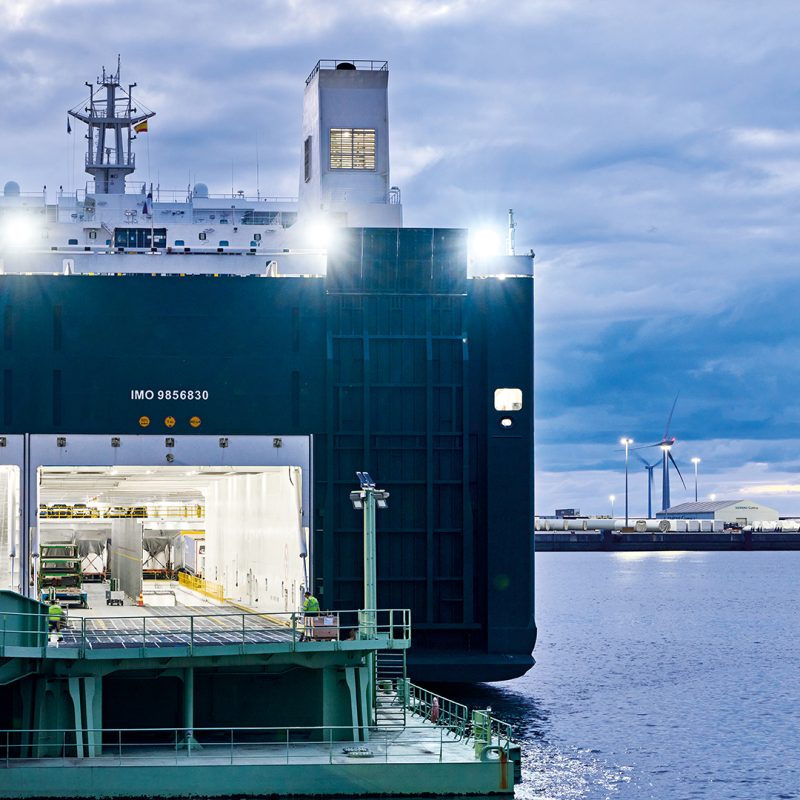Business environment
Finnlines’ business areas include the Baltic Sea, the North Sea and the Bay of Biscay. High-frequency liner traffic between Finland and Sweden, Continental Europe and Britain is the foundation of Finnlines’ operations and the company is one of the largest in ensuring Finland’s security of supply.

Global economic uncertainty remains high, despite surprisingly strong growth in the end of 2022. Overall, growth has slowed down, inflation has accelerated and Russia’s ongoing war in Ukraine has continued to push up energy prices. Sanctions against Russia have affected the whole EU economy, raising energy costs and leading to a slowdown. The overall outlook remains uncertain.
Market development
According to the International Monetary Fund (IMF), world GDP growth is forecast to slow from 3.4 per cent in 2022 to 2.9 per cent in 2023. The euro area GDP growth is forecast to decline from 3.5 per cent in 2022 to 0.7 per cent in 2023. Finland’s GDP growth is forecast to decline from 2.1 per cent in 2022 to 0.5 per cent 2023.
Global inflation is forecast to remain high and the pace of decline will vary across countries. The IMF forecasts global inflation to decline from 8.8 per cent in 2022 to 6.6 per cent in the euro area, inflation peaked at 10.6 per cent in October, but the annual average inflation is expected to fall from 8.3 per cent in 2022 to 5.7 per cent in 2023. In Finland inflation is forecast to decline from 6.5 per cent in 2022 to 3.5 per cent in 2023.
Based on the statistics by Traficom, the Finnish seaborne imports carried in containers, lorries and trailer units increased by 2 per cent to 11.6 million tonnes in 2022, but exports decreased by 3 per cent to 16.1 million tonnes. According to Statistics Finland, commercial passenger traffic between Finland and Sweden increased by 112 per cent, between Finland and Germany by 47 per cent in 2022.
Operating area
The company’s cargo-passenger vessels offer services between Finland and Germany and, via the Åland Islands, between Finland and Sweden, as well as between Sweden and Germany. The ro-ro vessels operate in the Baltic Sea, the North Sea, and the Bay of Biscay. The company has subsidiaries and sales offices in Germany, Belgium, Great Britain, Sweden, Denmark, and Poland.
As an agent for Grimaldi Lines and Atlantic Container Line (ACL) in Finland, Finnlines connects via Antwerp Helsinki, Kotka in Finland, Paldiski in Estonia and Travemünde in Germany with the Grimaldi Group network in the Mediterranean, West Africa, as well as the Atlantic coast of both North and South America.
At the beginning of the year, Finnlines doubled the number of departures on the Hanko–Gdynia service.
At the end of January, Finnlines upgraded its services to cargo customers and private passengers between Finland and Sweden. Europalink replaced Finnfellow and joined her sister ship Finnswan on the Naantali–Långnäs–Kapellskär route.
Due to EU sanctions Finnlines stopped calling Russian ports in early March.
In July, Finnlines launched a new freight route between Rosslare, Ireland, and Zeebrügge, Belgium, providing an important link between Ireland and the Continental Europe. This line was welcomed by the market and a smaller ro-ro vessel was soon replaced by a larger vessel with 4,200 lane metres for cargo.
Finnlines fleet
All three Eco-class ro-ro vessels, Finneco I, Finneco II and Finneco III, were delivered to Finnlines during the second quarter of 2022. In the middle of June, Finneco I entered the Biscay traffic increasing the capacity on the line. Simultaneously, Finntide was shifted to Baltic traffics replacing Finnmerchant, which was chartered out at the beginning of July. Two other Eco-class vessels, Finneco II and III, started regular service in July 2022.
At the end of the first quarter, Finnclipper, which had operated in Finnlines’ Malmö–Travemünde traffic as the fourth vessel, was sold to the Grimaldi Group, and Vizzavona (ex Finneagle) was purchased back. The chartered ro-ro vessel, Eurocargo Savona, returned to the Grimaldi Group in mid-March 2022. The Grimaldi Group’s and Finnlines’ ability to switch ro-ro and ro-pax vessels between the Mediterranean and Baltic Sea increases the capacity to provide services to our customers as needed and flexibility in the network when
planning capacity.
Finnlines owns a fleet of 23 vessels. The average age of the Group’s vessels was about 15 years.